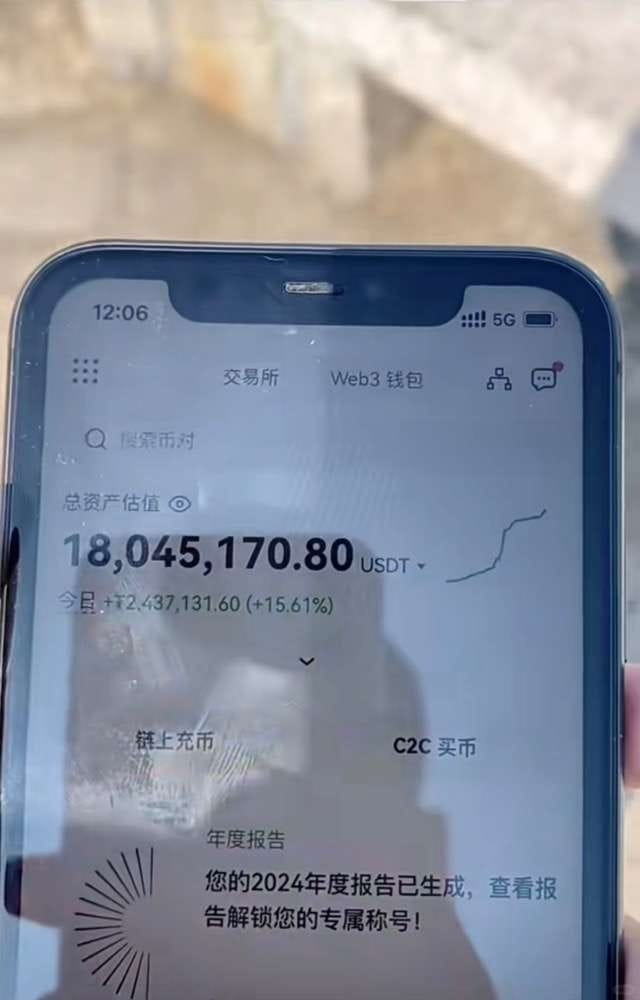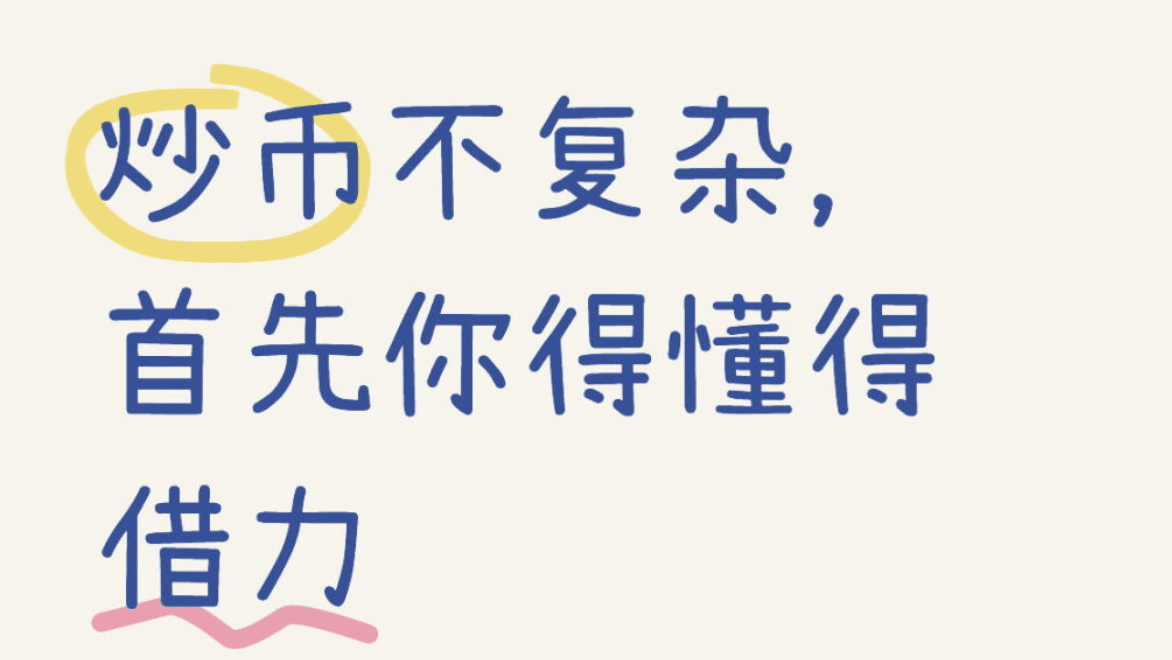I have been trading in cryptocurrencies for more than ten years. From my margin call to achieving financial freedom and supporting my family through crypto trading, my funds have increased 50 times in 2024. If I had not withdrawn funds twice to buy a house, it would have increased 85 times.
Today I will share my trading strategies and experiences with my friends in the cryptocurrency circle.
There is a saying that if you stand on the shoulders of giants, you will struggle ten years less.
At the end of the article, I will also tell you the most important dry goods content
Friends who have the opportunity to see this and want to improve their level in the cryptocurrency circle must read more and study carefully. It is recommended to collect it!

To put it bluntly, the turnaround of small funds depends on two words: position control + rhythm.
How to play it? Let me show you:
Step 1: Divide warehouses like building blocks, and do not make random moves in the three-part layout
800U. I told him to take one-third to place his first order and keep the rest. Remember: never add to your position without a signal, don't buy the dip, and don't hold on to losses. With limited funds, you have to be more careful and spend every penny wisely.
Step 2: Only invest in the market where you are sure of success and never invest in the market when it is volatile.
Finding a trading position is like shooting; aim first, then pull the trigger. If I can't take advantage of a market all at once, I'll break it down into three stages: first, catch the initial move, second, ride the pullback, and third, follow the continuation. During periods of volatility, I simply close the software and avoid unnecessary trades.
Step 3: Roll profits like a snowball, and keep your stop loss firmly fixed
If you make 100U on your first trade, immediately roll that 100U over as new capital. Increase your position slowly, but never exceed 30% of your principal. Use profits only to generate profits, never to gamble big—controlling your position is the key to snowballing your profits.
Step 4: Quit when you are ahead. When others are going crazy, I will withdraw first.
When others chase rising prices and get blown out, I guide them to take profits; when others sell at a loss, we enter the market at a rhythmic pace. We don't seek to take advantage of the entire market, but we profit from every stage. Turning over a position is never about gambling; it's about the gradual accumulation of compound interest.
This strategy is particularly suitable for small capital. The smaller the capital, the more you can rely on rhythm to create big moves.
I've seen countless small-capital traders anxiously watching the market, their orders haphazardly arranged, and ultimately, the more they lose, the more anxious they become. But when I lead trades, I never gamble; I rely on a steady, steady approach—rolling over positions is just a side effect; the key is to keep my account a little bigger each day than the day before.
The dumbest way to trade in cryptocurrencies is actually the “stupid method” that I have been sticking to over the past few years.
When I first started, I chased the hottest trends: buying local stocks, IPOs, opening contracts, using arbitrage bots... I'd be aggressive, but the returns would be nothing. It took me a while to finally understand: the more fancy you are, the easier it is to be killed; the more clumsy you are, the safer you are.
My "silly tricks" only have three steps, even my mother can understand them:
1️⃣ Only stock up on hard currency, don’t touch fancy things
The currency pool is extremely small: BTC, ETH, and a "second" one that I truly understand. No matter how popular the others are, if you're still confused after reading the white paper three times, block them immediately. Only by maintaining a bottom line can you sleep well later.
2️⃣ Payday = coin purchase day, swipe the card for both price fluctuations
Every month on payday, I'd transfer a fixed percentage to the exchange to buy stocks, rain or shine. Buy when the market goes up, buy even more when it goes down. I treated the candlestick charts like background music, spreading the costs out. Over the course of three years, my account, like a reservoir, had grown deeper without me noticing.
3️⃣ Unplug the network cable after setting up the "dual line"
Before entering the market, I write down two lines: one for take-profit and one for stop-loss. I place orders at the appointed time, then uninstall the app and write down my password on a piece of paper and lock it in a drawer. During the market crash last April, I was in western Sichuan with no signal, but I still managed to avoid a 50% drop. This was all thanks to the "iron rule" I'd written down beforehand.
Why do “slow” people outperform most people?
• No anxiety: I don’t watch the market, the ups and downs of the market have nothing to do with my daily routine
• Make fewer mistakes: No matter how fast the hot spots rotate, they can’t catch up with me and I will stay put.
• Save chips: Monthly salary turns into digital gold, time works for me
Of course, this approach has its drawbacks: in the short term, it's certainly boring, and you can only smile when you see people in social media sharing their 100x-performing coins. But in the long term, it's worry-free, allowing you to sleep soundly even in a bear market. Slowness doesn't mean losing; it means turning risk into compound interest.
The core of trading has never been to frequently shuttle between the markets, but to learn to accurately capture the best point of entry while waiting - this itself is an art that requires practice.
Choosing to remain inactive doesn't mean being at a loss for market trends, but rather understanding the underlying principles behind their ups and downs, with a clear strategy and rhythm in mind. The market is always filled with chaotic signals, but the true drivers of profit and loss are often those 5% of key trades, which act like leverage, generating 95% of returns. This composure isn't passive observation, but a proactive choice rooted in strategy. In other fields, waiting can mean missing opportunities, but in the world of trading, the patience of "sitting by the tree and waiting for the rabbit" is precisely the winning tactic of top players.
Markets are constantly changing, and novices are often swept along by fluctuations, chasing rising hot spots one day and falling pullbacks the next. While seemingly overwhelmed, they are actually manipulated by market sentiment, ultimately leaving them physically and mentally exhausted. Experienced traders, on the other hand, will identify their target in advance, understanding its fluctuation rhythm, operating patterns, and inherent characteristics. Like a hunter waiting for their prey to enter optimal range, they strike decisively once the opportunity is right, securing the winning shot.
We don't have to hope to outsmart the market, but we can build a trading system that suits us. Define boundaries with rules, anchor our direction with goals, maintain composure when it's time to lie low, and never hesitate when it's time to act, ensuring every trade is executed quickly, accurately, and steadily.
We must be as sensitive to subtle market fluctuations as we are to the scent of a rose, yet be able to calmly manage the overall situation as if facing a fierce tiger. Don't become overjoyed when you make a profit, nor become anxious and insane when you suffer a loss. Maintain a stable mindset—after all, no matter who wins or loses, the wheel of the market never stops for anyone.
This is the deep logic and essence of trading.

In the cryptocurrency world, I went from losing all my capital to exiting with 40 million yuan, and I realized one thing: if you can control your emotions, the market will be a machine that allows you to withdraw money at will.
At the celebration party, he said: "A cryptocurrency expert is simply someone who can hold back during a sharp drop and resist the temptation during a surge." His emotional management mantra is broken down into six simple steps:
1. Entry: While others are rushing in, draw 3 lines first.
No matter how hot a new coin is, you still need to wait for these three signals: the high and low lines of the past three days, the support level of the 5-day moving average, and the critical point of increased trading volume. Use a 5% position for trial and error, and don't enter the market without a signal.
2. Sideways: Others can’t stand it and cut their positions, but you add to your positions according to the calculator.
When the market is sideways, if the keyword "cut meat" in the community exceeds 500 times, you should cover your position with profits, and don't use the principal.
3. Fluctuation: Check support for sharp drops and take profit for sharp rises
If the price plummets, look at the previous low support and panic index. If the price surges, sell 30% first and set a trailing stop loss for the rest.
4. Contrary: Buy Yin and wait for 3 signals, sell Yang ruthlessly
Buy Yin: Yin line is long enough, has not broken the previous low, and the trading volume is enlarged. Sell Yang: If the body exceeds 5%, sell half first.
5. Risk: Don’t fully invest, keep 30% in cash
The single currency position does not exceed 20% of the total funds, and the total position does not exceed 70%. Cash is used as an emotional buffer.
6. Review: Others criticize the market, you write down your mistakes
Keep 3 points in mind for every loss: Did you follow the trend? Did you follow the stop-loss rules? Did you add to your position with your principal or profit?
“Every penny earned in the cryptocurrency world is a reward for emotional control.”

My iron rule for entering the market (none of them can be missing):
The price must remain above the 30-day moving average for three days (evidence of an upward trend);
If you enter the market after a big drop, you must meet three conditions at the same time:
Volume has shrunk to below 40% of its 30-day average (selling pressure is almost gone);
The net inflow of stablecoins increased by more than 15% week-on-week (funds are quietly entering the market);
The contract funding rate turned from positive to negative (market panic is obvious, it's time for a rebound).
My three stop-loss lines (engraved on the trading software):
Time stop-loss: If there is no profit sign in the position for 24 hours, exit the market immediately (don’t waste time, time is also a cost);
Stop-loss: If the floating loss exceeds 3% of the principal, a forced stop-loss will be triggered (regardless of whether there will be a rebound, the priority is to save life);
Emotional stop loss: After two consecutive misjudgments, stop trading for three days (when emotions are high, the accuracy of operations is less than 10%).
The cryptocurrency world has never lacked believers; what's lacking is people who understand where the money is flowing. Rising prices aren't driven by hype, and falling prices aren't driven by emotions. Behind all fluctuations, the footprints of capital are hidden in volume and price.
✅ Main action recognition (see these signals):
Signal to open a position:
On a breakout to the upside, volume reaches 3 times the 30-day average (real money is entering the market);
Frequent large-value transfers on the chain (big whales are quietly stockpiling);
The net outflow of USDT from exchanges lasted for more than three days (funds shifted from stablecoins to spot trading).
Risk signals:
The price hits a new high but the trading volume "lags behind" (the price has stopped rising and the main players are selling);
Borrowing rates have dropped significantly (no one wants to borrow money to buy, the enthusiasm is fading);
The concentration of chips increases (a few people hold a large number of chips and can crash the market at any time).
The four-factor model determines the "rebound critical point" (take action only if all four conditions are met):
The correction from the historical high is more than 30% (there is room for further decline only after it has fallen through);
The 120-day moving average is flat (the long-term trend has stopped falling);
The weekly RSI falls back to the 40-50 range (neither overbought nor oversold, sentiment is stable);
Perpetual contract open interest hit a 3-month low (no one dares to bet anymore, so the opportunity has arrived).
My currency management mechanism (updated monthly):
If the 5-day volatility is less than 3%, it will be directly eliminated (no volatility, no profit);
If the market capitalization ranking drops by more than 10 places, it will be permanently removed from the watchlist (abandoned by funds);
The target pool remains "active": only 13% of the core currency is retained (more than that cannot be managed).
Epilogue: Those who survived are all “honest people”
Over the past decade, I've seen countless technical experts and short-term geniuses perish in the market. Those who remain are mostly "honest people" like me: those who follow simple rules, constantly review their performance, and respect the market.
I still have three habits:
Check on-chain data and fund flows every morning (to know where the money is going);
Review your trading mistakes three times a week (e.g., “I didn’t set a stop loss this time, why?”);
Backtest the strategy once a month (the market changes and the rules need to be fine-tuned).
If you're struggling, try:
Print out your worst losing trades and compare them against these six truths one by one to find loopholes;
For the next transaction, the single loss must be controlled to no more than 3%;
Don’t buy too much. Leave enough for 6 months of living expenses first - being alive is more important than anything else.